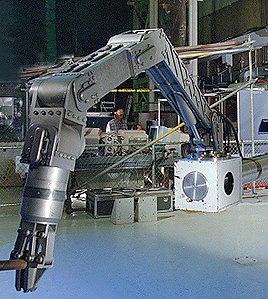
Semi Autonomous Robotic Manipulator
The core of a nuclear reactor is often located underwater and hence robots must be capable of underwater motion. One such example is of a robot developed in China by the Chinese Academy of Sciences. It is equppied with a vision system and capable of searching and operation. It also has a vacuum pump such that it can suck up small items for clean up purposes, and also equipped with a gripper to hold spanners or screwdrivers and can be utilized for maintenance or repairs.

Robots in such an industry could become increasingly more advanced such that they can become autonomous and for example, can carry out the daily tasks of running a nuclear reactor. I believe this will allow the removal of humans from the radioactive site and ensure that the safety of the workers at such a reactor is not compromised. In existing nuclear plants, the robots must be capable of stairs navigation and such a robot is developed in India, whereby it is six legged and capable of moving around and over obstacles. In my opinion, the robot from China is limited to certain places and not capable of complex navigation due to it being wheel-based.
References:
Seah Qiong Feng Sean U036739M
3 comments:
Maybe China's nuclear reactors are not as advanced as India's. Thus no need to overcome steps. (randomly guessing)
Other than being able to go underwater, is that all there is to this robot compared to any normal robot? For example, does it need to be protected against nuclear radiation?
I guess control must be very precise. One wrong milimeter and *boom* I wonder what sort of control system they use. PID?
Chen ZhaoLin
U036701H
I think the difference between the two country's robots are their choice of usage. As in for China's, the main use is to service the core nuclear reactor as opposed to India whereby it is more of a general purpose one, hence the different locomotive needs.
Robots in general do not need to be protected for nuclear radiation as metal can withstand it. That's why it is so useful in this industry.
I'm not too sure about control, it seems like not much information is released, I guess there is a large shroud of secrecy surrounding the matter, haha.
Seah Qiong Feng Sean
U036739M
Firstly, i hope that if they ever use PID controller.. they had better be of higher quality than those in our labs! Haha..
On a serious note, hopefully robots won't be abused in the development of nuclear weapons etc where there has been so much debate. (Although i guess they have already been employed in one way or another). The development of robots really poses a double-edge sword to mankind.. If used properly, it can indeed provide assistance and render great help as in this case. But if it's really used for the wrong reasons, we could really be in for a rough ride...
Alvin Ong
U036077M
Post a Comment